|
More than 25 years into the AIDS epidemic, HIV
infection continues to exact a tremendous toll in
the United States. Recent data indicate that African
Americans and gay and bisexual men of all races
continue to be most severely affected.
Estimates of HIV Prevalence
The latest estimates indicate that at the end of 2003,
HIV prevalence— the total number of persons
with HIV—was roughly 1 million (estimated range
between 1,039,000–1,185,000) [1]. Approximately
one-fourth (24% –27%) of HIV-infected persons
are believed to be unaware of their infection,
underscoring the need to expand opportunities for
HIV testing.
An estimated 47% of the persons living with
HIV were black, 34% were white, and 17% were
Hispanic. Asians/Pacific Islanders and American
Indians/Alaska Natives each represented roughly 1%
of the HIV-infected population.
Males accounted for 74% of the population living
with HIV.
The largest population living with HIV (45%)
comprised men who have sex with men (MSM),
followed by persons infected through high-risk
heterosexual contact (27%), those infected through
injection drug use (22%), and those who were
exposed through both male-to-male sexual contact
and injection drug use (5%).
Race/ethnicity of persons living with HIV, 2003
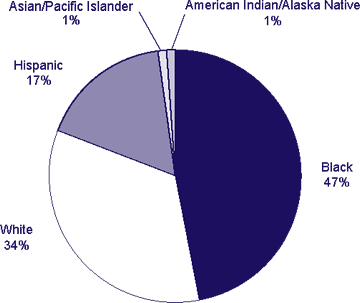
Sex of persons living with HIV, 2003
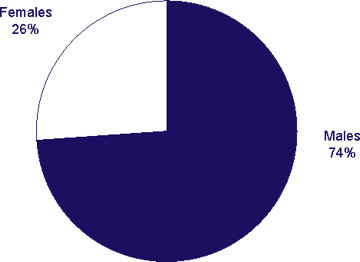
Transmission category for persons living with
HIV, 2003
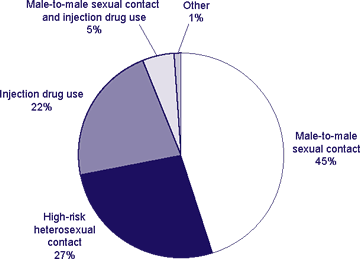
Researchers believe that these estimates point to
an increased need for HIV testing, prevention,
and treatment services to slow the US epidemic.
As persons with HIV are now living longer than
ever before, a growing population of HIV-infected
men and women must be reached with testing and
prevention services to help them protect others
from infection. Additionally, increasing HIV
prevalence means increased opportunities for
transmission to HIV-negative persons who engage
in risky behaviors. Efforts to reduce the number of
new infections must therefore meet the needs of
populations that are infected and populations that are
not infected.
HIV prevalence differs from HIV incidence:
incidence reflects the number of new HIV infections
each year. CDC recently announced
the first national system for determining HIV
incidence on the basis of direct measurement of new
HIV infections. This new technology distinguishes
recent HIV infections from long-standing infections
and provides critical information in tracking
the US epidemic. In addition, it provides
the clearest picture to date of HIV infections in
the United States and over time and will benefit the populations at highest risk
by better focusing HIV prevention efforts and helping to measure progress. In
2006, 56,300 individuals were infected with HIV [2].
Estimated Number of New HIV
Diagnoses, 2006
CDC’s analysis of HIV diagnoses includes all new
HIV diagnoses, with or without an AIDS diagnosis,
in the 33 states that have long-standing confidential,
name-based HIV infection reporting systems.*
HIV diagnoses do not necessarily represent new
infections: some persons with a new HIV diagnosis
were infected recently; others were infected long
ago, but their infection was detected only recently.
Additionally, although the inclusion of New York
State data since 2001 provides a sample of diagnoses
that is more representative than the sample from
earlier analyses, several high-morbidity areas
(including California and Illinois) lack longstanding,
name-based reporting and are still not
included in this analysis.
An analysis of persons with a diagnosis of HIV
infection, by race/ethnicity and risk factor,
underscores the disproportionate impact of HIV
among communities of color and MSM of all races:
- By race/ethnicity, nearly half (49%) were
black, although blacks made up only 13% of
the population of the 33 states [3]. Whites
accounted for 30% of diagnoses, and Hispanics
accounted for 18%. Asians/Pacific Islanders
and American Indians/Alaska Natives each
accounted for 1% or less of diagnoses.
- By age, more than half (57%) were aged
25–44. Children younger than 13 years
accounted for less than 1% of diagnoses.
- Among adults and
adolescents:
- By transmission category, MSM continued
to account for the largest number of
diagnoses overall, followed by males
and females exposed through high-risk
heterosexual contact and injection
drug use.
- By sex, males accounted for 73% of all new
HIV diagnoses in 2006.
- Among males, most diagnoses were for MSM. Although past analyses indicate
this is true regardless of race, high-risk
heterosexual contact also accounts for
a considerable proportion of new HIV
diagnoses among men of minority races/
ethnicities [4, 5]
- Among females, most diagnoses were
for those exposed through high-risk
heterosexual contact.
Race/ethnicity of persons with a new HIV diagnosis
in 2006
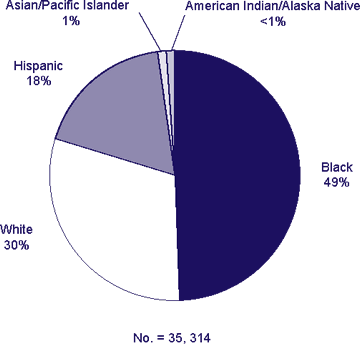
Transmission category for persons with a new HIV
diagnosis in 2006

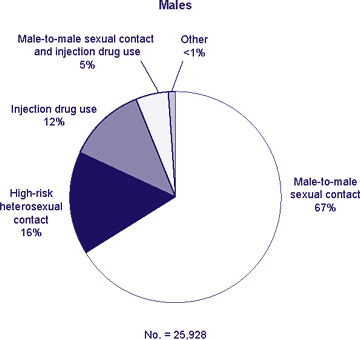
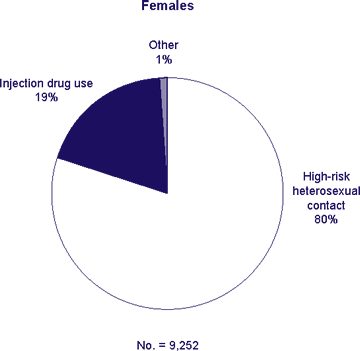
Age groups of persons with a new HIV diagnosis
in 2006
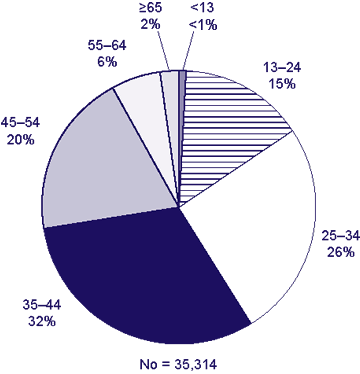
Estimated Rates of HIV
Diagnosis, 2006
Disparities among Races/Ethnicities Persist
In 2006, the overall rate of HIV diagnosis (the
number of diagnoses per 100,000 population) in
the 33 states was 18.5 per 100,000 [3]. The rate for
blacks was roughly 8 times the rate for whites (67.7
per 100,000 vs 8.2 per 100,000).
African American males continue to bear the greatest
burden of HIV infection. In 2006, the HIV diagnosis
rate for all black males in 33 states (119.1 per
100,000 population) was the highest of any group—
more than 7 times that for white males (16.7),
more than twice the rate for Hispanic males (50.9),
and more than twice the rate for black females
(56.2). The diagnosis rate for Hispanic males was
approximately 3 times that for white males.
African American females are also severely and
disproportionately affected by HIV infection. In
2006, the HIV diagnosis rate for black females (56.2)
was more than 19 times the rate for white females
(2.9). The rate for Hispanic women was 15.1, more
than 5 times that for white females.
Among American Indians/Alaska Natives, the rate
of HIV diagnosis for males (17.7) was slightly
higher than the rate for white males, and the rate for females (4.6) was nearly twice the rate for white
females. Among Asians/Pacific Islanders, the rate of
HIV diagnosis for males was 13.5, and the rate for
females was 3.2.
Rates of HIV Diagnosis, 2006

Multiple Challenges Place African Americans
and Hispanics/Latinos at Increased Risk
Race and ethnicity are not, by themselves, risk
factors for HIV infection. But studies show that
African Americans and Hispanics/Latinos are more
likely than their white counterparts to face multiple
challenges associated with risk for HIV infection.
These challenges include high rates of sexually
transmitted diseases, which can facilitate HIV
transmission [6, 7]; substance abuse, which may
increase the risk for HIV infection through sexual
or drug-related transmission [8]; and socioeconomic
factors, such as limited access to high-quality health
care [9]. Studies have also suggested that poverty
may place African American women at increased risk
because of the power imbalance created by financial
dependence on men [10]. Among MSM of minority
races/ethnicities, cultural barriers that may impede
the acknowledgment of risk behaviors and the ability
to access prevention services may result in increased
risk [11–15]. For Hispanics/Latinos, language
barriers may also affect the quality of care [16].
Additionally, because many Hispanics/Latinos or
their parents have emigrated from diverse countries
or regions, there is no single culture for persons of Spanish origin in the United States. Research shows that Hispanics/Latinos
born in different countries have different behavioral risk factors for
HIV [3, 17].
AIDS Cases and Deaths
AIDS cases and deaths, reported from all US states and the District of
Columbia, provide a valuable measure of the impact of the disease in
various areas and populations. In the mid-to-late 1990s, advances in
HIV treatments led to dramatic declines in AIDS deaths and slowed the
progression from HIV infection to AIDS.
In general, the trend in the estimated number of AIDS cases and deaths
remained stable from 2002 through 2005. Estimates for 2006 suggest that
the number of AIDS cases remained stable and that the number of AIDS
deaths decreased, but it is too early to determine whether these trends
will hold. The decrease in estimated deaths is likely due to delays in the
reporting of deaths; there is always greater uncertainty about the data
estimates for the most recent year (estimates are refined as additional data
are received). Estimated numbers of AIDS cases and deaths of persons with AIDS
2002–2006
| Year |
Estimated Number of
AIDS Cases |
Estimated Number of
Deaths Among Persons with AIDS |
| 2006 |
36,828 |
14,016 |
| 2005 |
36,552 |
16,268 |
| 2004 |
37,726 |
16,395 |
| 2003 |
38,538 |
16,690 |
| 2002 |
38,132 |
16,948 |
By race/ethnicity, African Americans continue to be most severely affected
by AIDS. In 2006, rates of AIDS cases were 47.6 per 100,000 for blacks,
15.6 for Hispanics, 6.2 for American Indians/Alaska Natives, 5.4 for whites,
and 3.7 for Asians/Pacific Islanders. Among adults and adolescents, rates of
AIDS cases were highest for black males (82.9 per 100,000), followed by
black females (40.4) and Hispanic males (31.3). The AIDS rate for Hispanic
females was 9.5 per 100,000. AIDS rates for white males and females
were 11.2 and 1.9 per 100,000, respectively. AIDS rates for American
Indian/Alaska Native males and females were 12.2 and 3.6 per 100,000,
respectively, and AIDS rates among Asian/Pacific Islander males and
females were 7.5 and 1.6 per 100,000, respectively.
National Center for HIV/AIDS, Viral Hepatitis, STD, and TB Prevention (NCHHSTP)
Office of Communication
404-639-8895 (Media Line)
REFERENCES
- Glynn M, et al. Estimated HIV
prevalence in the United States at the
end of 2003. National HIV Prevention
Conference; June 12–15, 2005; Atlanta.
Abstract T1-B1101.
- Hall HI, Ruiguang S, Rhodes P, et al. Estimation of HIV incidence in the United States.
JAMA. 2008;300:520-529.
- CDC.
HIV/AIDS Surveillance Report,
2006. Vol. 18. Atlanta: US Department
of Health and Human Services, CDC;
2008.
- CDC.
Trends in HIV/AIDS
diagnoses—33 states, 2001–2004. MMWR 2005;54:1149–53.
- CDC.
Update to racial/ethnic disparities
in diagnoses of HIV/AIDS—33 states,
2001–2005. MMWR 2007;56:189–93.
- Fleming DT, Wasserheit JN. From
epidemiological synergy to public health
policy and practice: the contribution of
other sexually transmitted diseases to
sexual transmission of HIV infection.
Sex Transm Infect 1999;75:3–17.
- CDC. Sexually Transmitted Disease
Surveillance, 2006. Atlanta: US Department of Health and Human Services,
CDC; Nov 2007.
- Leigh B, Stall R. Substance use and
risky sexual behavior for exposure
to HIV: issues in methodology,
interpretation, and prevention. Am Psychol 1993;48:1035–45.
- Diaz T, et al. Socioeconomic differences
among people with AIDS: results from
a multistate surveillance project. Am J Prev Med 1994;10:217–22.
- CDC.
HIV transmission among black
women—North Carolina, 2004. MMWR 2005;54:89–93.
- CDC.
HIV/AIDS among racial/ethnic
minority men who have sex with men,
1989–1998. MMWR 2000;49:4–11.
- CDC.
HIV/STD risks in young men
who have sex with men who do not
disclose their sexual orientation—six
US cities, 1994–2000. MMWR
2003;52:81–85.
- CDC.
HIV transmission among
black college student and nonstudent
men who have sex with
men—North Carolina, 2003. MMWR
2004;52:731–4.
- Montgomery JP, et al.. The extent of
bisexual behaviour in HIV-infected
men and implications for transmission
to their female sex partners. AIDS Care
2003;15:829–37.
- Diaz R. Latino gay men and psychocultural
barriers to AIDS prevention.
In: Levin MP, Nardi PM, Gagnon JH,
eds. In Changing Times: Gay Men
and Lesbians Encounter HIV/AIDS.
Chicago: University of Chicago
Press; 1997.
- Timmins CL. The impact of language
barriers on the healthcare of Latinos
in the United States: a review of
the literature and guidelines for
practice. J Midwifery Womens Health
2002;47(2):80–96.
- CDC.
HIV/AIDS among Hispanics—
United States, 2001–2005. MMWR
2007;56:1052–7.
* These states are: Alabama, Alaska, Arizona, Arkansas, Colorado,
Florida, Idaho, Indiana, Iowa, Kansas, Louisiana, Michigan, Minnesota,
Mississippi, Missouri, Nebraska, Nevada, New Jersey, New Mexico,
New York, North Carolina, North Dakota, Ohio, Oklahoma, South
Carolina, South Dakota, Tennessee, Texas, Utah, Virginia, West Virginia,
Wisconsin and Wyoming.
|